Aspects of Contract and Negligence
VerifiedAdded on 2020/01/28
|14
|4730
|44
Report
AI Summary
This report thoroughly examines aspects of contract and negligence within a business context. It begins by defining contracts and outlining essential elements for valid formation, including offer, acceptance, consideration, and capacity. Different contract types (express, implied, quasi, bilateral, unilateral) and their impacts are analyzed, along with the effects of express, implied, and exclusionary terms. The report then delves into case studies applying these concepts, demonstrating the consequences of classifying contractual terms (conditions, warranties, intermediate terms). A comparison of contractual and tort liability is presented, highlighting differences in the nature of liability, remoteness, causation, and damages. The nature of negligence liability is explained, covering duty of care, breach of duty, and causation. Vicarious liability is explored, detailing how businesses can be held responsible for employee actions. Further case studies illustrate the application of negligence and its defenses, along with the elements of vicarious liability. The report concludes by summarizing the key findings and their implications for businesses.
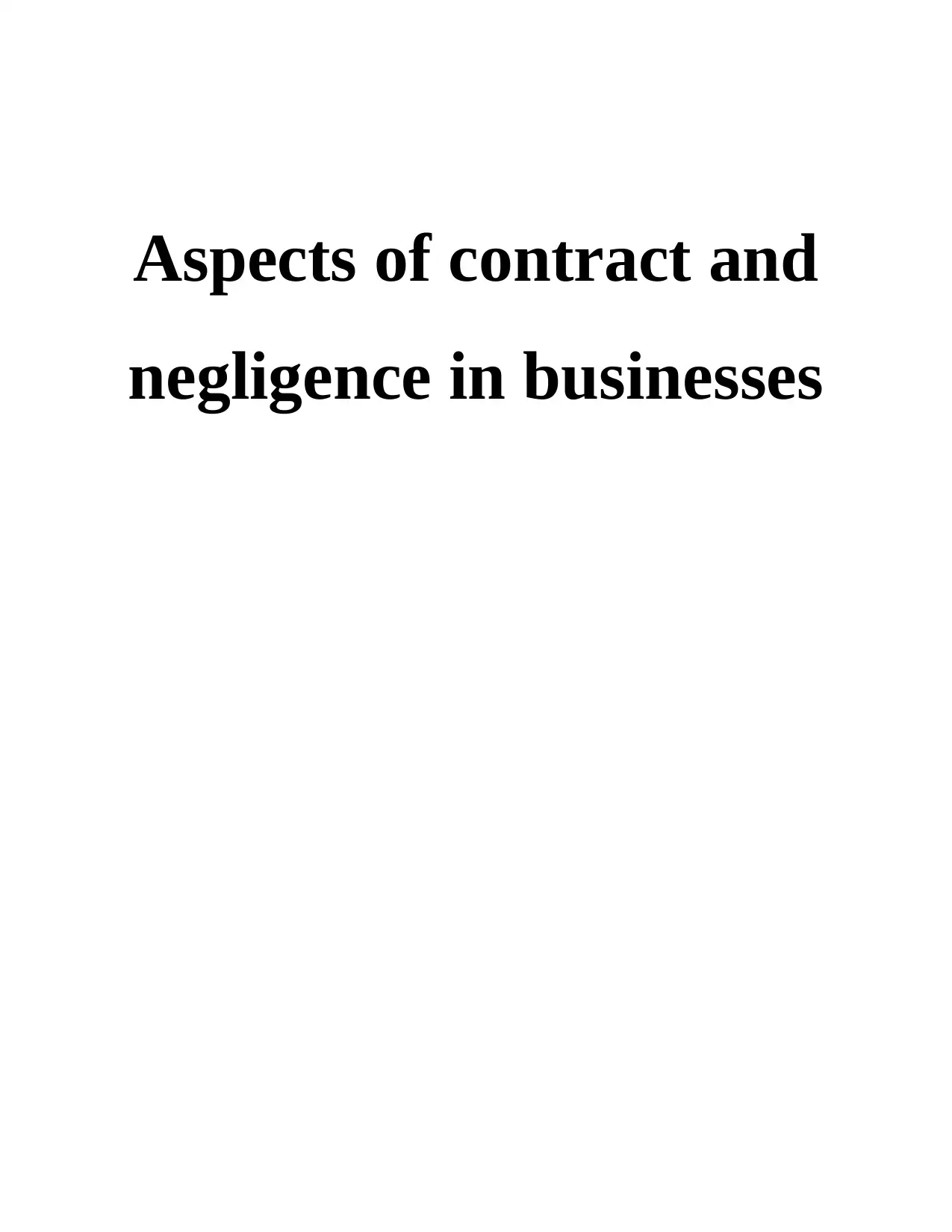
Aspects of contract and
negligence in businesses
negligence in businesses
Paraphrase This Document
Need a fresh take? Get an instant paraphrase of this document with our AI Paraphraser
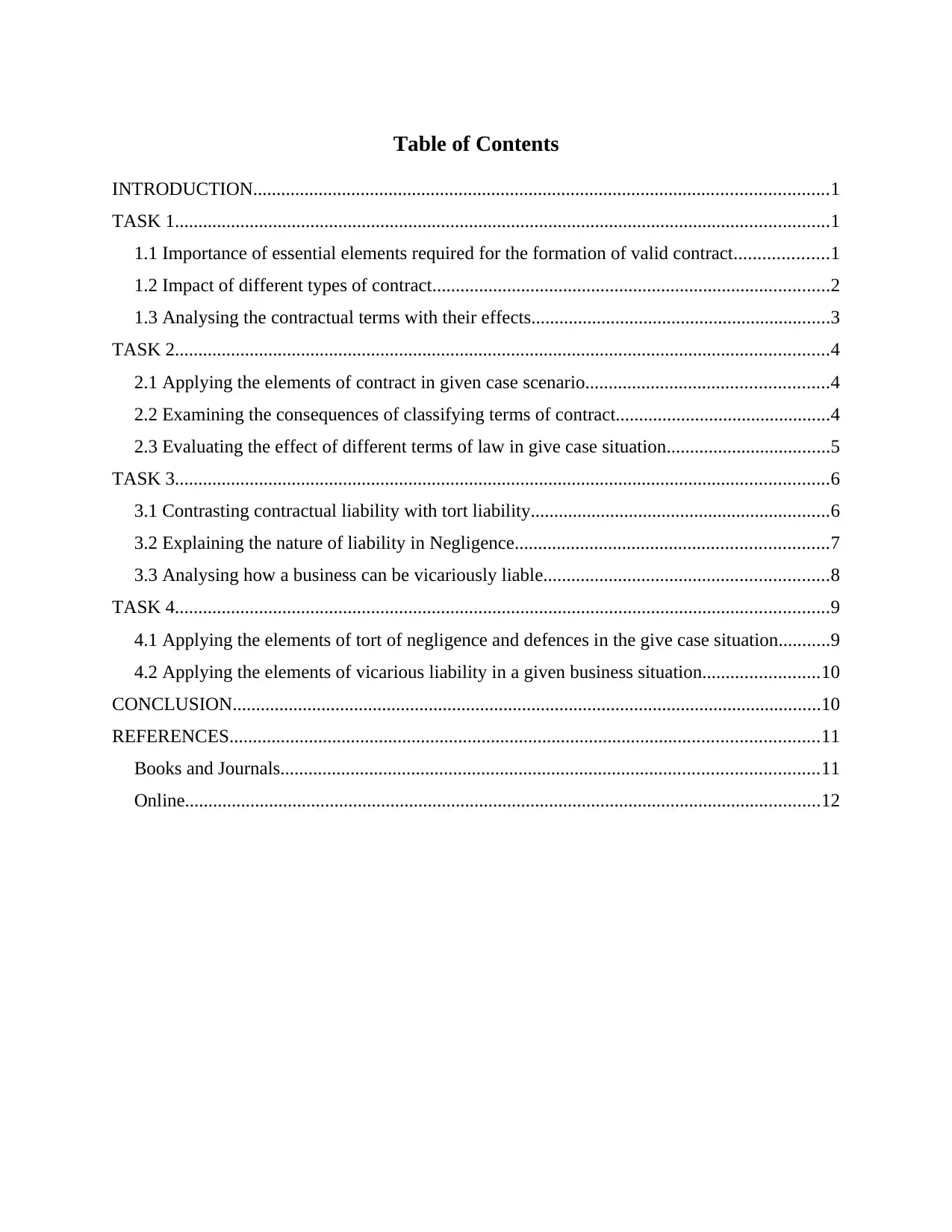
Table of Contents
INTRODUCTION...........................................................................................................................1
TASK 1............................................................................................................................................1
1.1 Importance of essential elements required for the formation of valid contract....................1
1.2 Impact of different types of contract.....................................................................................2
1.3 Analysing the contractual terms with their effects................................................................3
TASK 2............................................................................................................................................4
2.1 Applying the elements of contract in given case scenario....................................................4
2.2 Examining the consequences of classifying terms of contract..............................................4
2.3 Evaluating the effect of different terms of law in give case situation...................................5
TASK 3............................................................................................................................................6
3.1 Contrasting contractual liability with tort liability................................................................6
3.2 Explaining the nature of liability in Negligence...................................................................7
3.3 Analysing how a business can be vicariously liable.............................................................8
TASK 4............................................................................................................................................9
4.1 Applying the elements of tort of negligence and defences in the give case situation...........9
4.2 Applying the elements of vicarious liability in a given business situation.........................10
CONCLUSION..............................................................................................................................10
REFERENCES..............................................................................................................................11
Books and Journals...................................................................................................................11
Online........................................................................................................................................12
INTRODUCTION...........................................................................................................................1
TASK 1............................................................................................................................................1
1.1 Importance of essential elements required for the formation of valid contract....................1
1.2 Impact of different types of contract.....................................................................................2
1.3 Analysing the contractual terms with their effects................................................................3
TASK 2............................................................................................................................................4
2.1 Applying the elements of contract in given case scenario....................................................4
2.2 Examining the consequences of classifying terms of contract..............................................4
2.3 Evaluating the effect of different terms of law in give case situation...................................5
TASK 3............................................................................................................................................6
3.1 Contrasting contractual liability with tort liability................................................................6
3.2 Explaining the nature of liability in Negligence...................................................................7
3.3 Analysing how a business can be vicariously liable.............................................................8
TASK 4............................................................................................................................................9
4.1 Applying the elements of tort of negligence and defences in the give case situation...........9
4.2 Applying the elements of vicarious liability in a given business situation.........................10
CONCLUSION..............................................................................................................................10
REFERENCES..............................................................................................................................11
Books and Journals...................................................................................................................11
Online........................................................................................................................................12
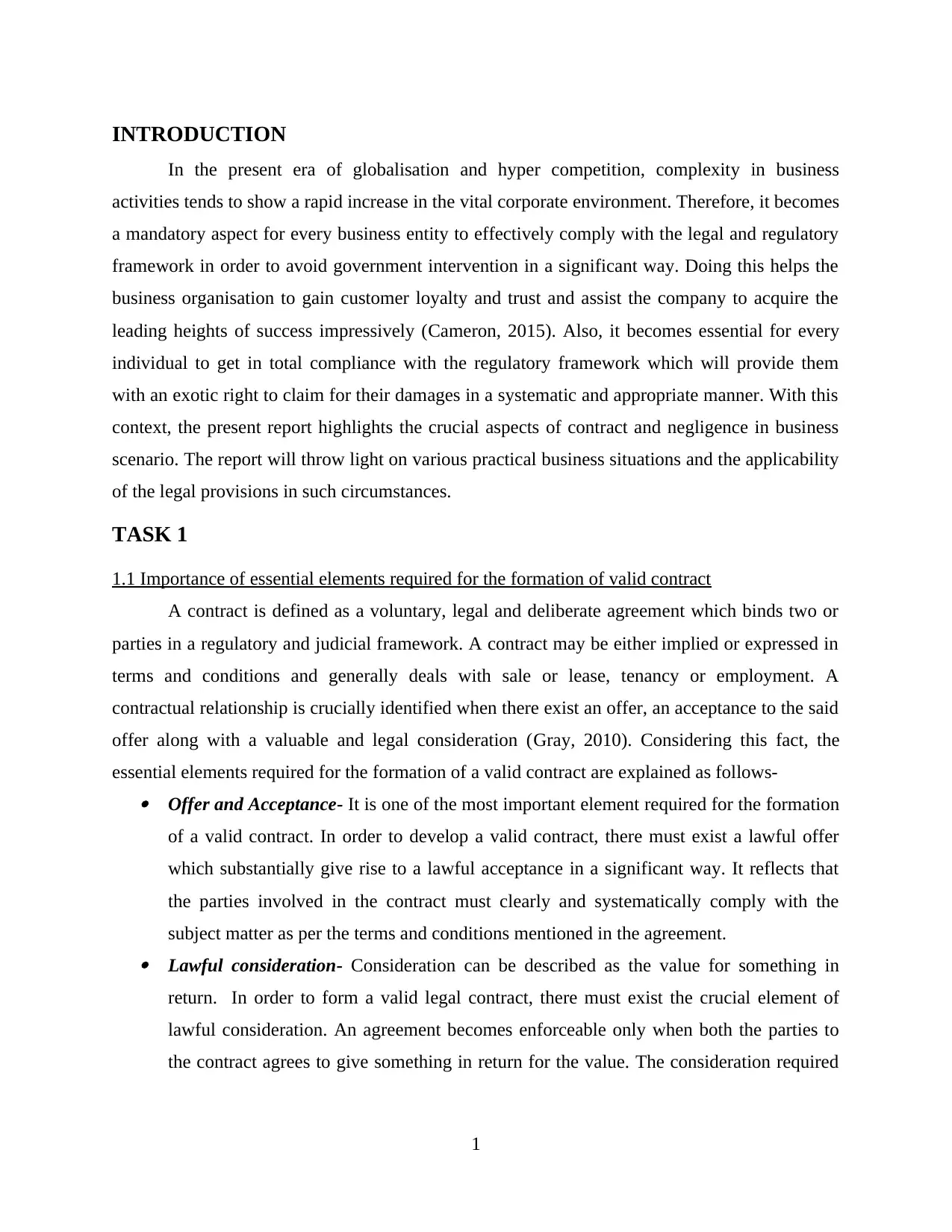
INTRODUCTION
In the present era of globalisation and hyper competition, complexity in business
activities tends to show a rapid increase in the vital corporate environment. Therefore, it becomes
a mandatory aspect for every business entity to effectively comply with the legal and regulatory
framework in order to avoid government intervention in a significant way. Doing this helps the
business organisation to gain customer loyalty and trust and assist the company to acquire the
leading heights of success impressively (Cameron, 2015). Also, it becomes essential for every
individual to get in total compliance with the regulatory framework which will provide them
with an exotic right to claim for their damages in a systematic and appropriate manner. With this
context, the present report highlights the crucial aspects of contract and negligence in business
scenario. The report will throw light on various practical business situations and the applicability
of the legal provisions in such circumstances.
TASK 1
1.1 Importance of essential elements required for the formation of valid contract
A contract is defined as a voluntary, legal and deliberate agreement which binds two or
parties in a regulatory and judicial framework. A contract may be either implied or expressed in
terms and conditions and generally deals with sale or lease, tenancy or employment. A
contractual relationship is crucially identified when there exist an offer, an acceptance to the said
offer along with a valuable and legal consideration (Gray, 2010). Considering this fact, the
essential elements required for the formation of a valid contract are explained as follows- Offer and Acceptance- It is one of the most important element required for the formation
of a valid contract. In order to develop a valid contract, there must exist a lawful offer
which substantially give rise to a lawful acceptance in a significant way. It reflects that
the parties involved in the contract must clearly and systematically comply with the
subject matter as per the terms and conditions mentioned in the agreement. Lawful consideration- Consideration can be described as the value for something in
return. In order to form a valid legal contract, there must exist the crucial element of
lawful consideration. An agreement becomes enforceable only when both the parties to
the contract agrees to give something in return for the value. The consideration required
1
In the present era of globalisation and hyper competition, complexity in business
activities tends to show a rapid increase in the vital corporate environment. Therefore, it becomes
a mandatory aspect for every business entity to effectively comply with the legal and regulatory
framework in order to avoid government intervention in a significant way. Doing this helps the
business organisation to gain customer loyalty and trust and assist the company to acquire the
leading heights of success impressively (Cameron, 2015). Also, it becomes essential for every
individual to get in total compliance with the regulatory framework which will provide them
with an exotic right to claim for their damages in a systematic and appropriate manner. With this
context, the present report highlights the crucial aspects of contract and negligence in business
scenario. The report will throw light on various practical business situations and the applicability
of the legal provisions in such circumstances.
TASK 1
1.1 Importance of essential elements required for the formation of valid contract
A contract is defined as a voluntary, legal and deliberate agreement which binds two or
parties in a regulatory and judicial framework. A contract may be either implied or expressed in
terms and conditions and generally deals with sale or lease, tenancy or employment. A
contractual relationship is crucially identified when there exist an offer, an acceptance to the said
offer along with a valuable and legal consideration (Gray, 2010). Considering this fact, the
essential elements required for the formation of a valid contract are explained as follows- Offer and Acceptance- It is one of the most important element required for the formation
of a valid contract. In order to develop a valid contract, there must exist a lawful offer
which substantially give rise to a lawful acceptance in a significant way. It reflects that
the parties involved in the contract must clearly and systematically comply with the
subject matter as per the terms and conditions mentioned in the agreement. Lawful consideration- Consideration can be described as the value for something in
return. In order to form a valid legal contract, there must exist the crucial element of
lawful consideration. An agreement becomes enforceable only when both the parties to
the contract agrees to give something in return for the value. The consideration required
1
⊘ This is a preview!⊘
Do you want full access?
Subscribe today to unlock all pages.

Trusted by 1+ million students worldwide
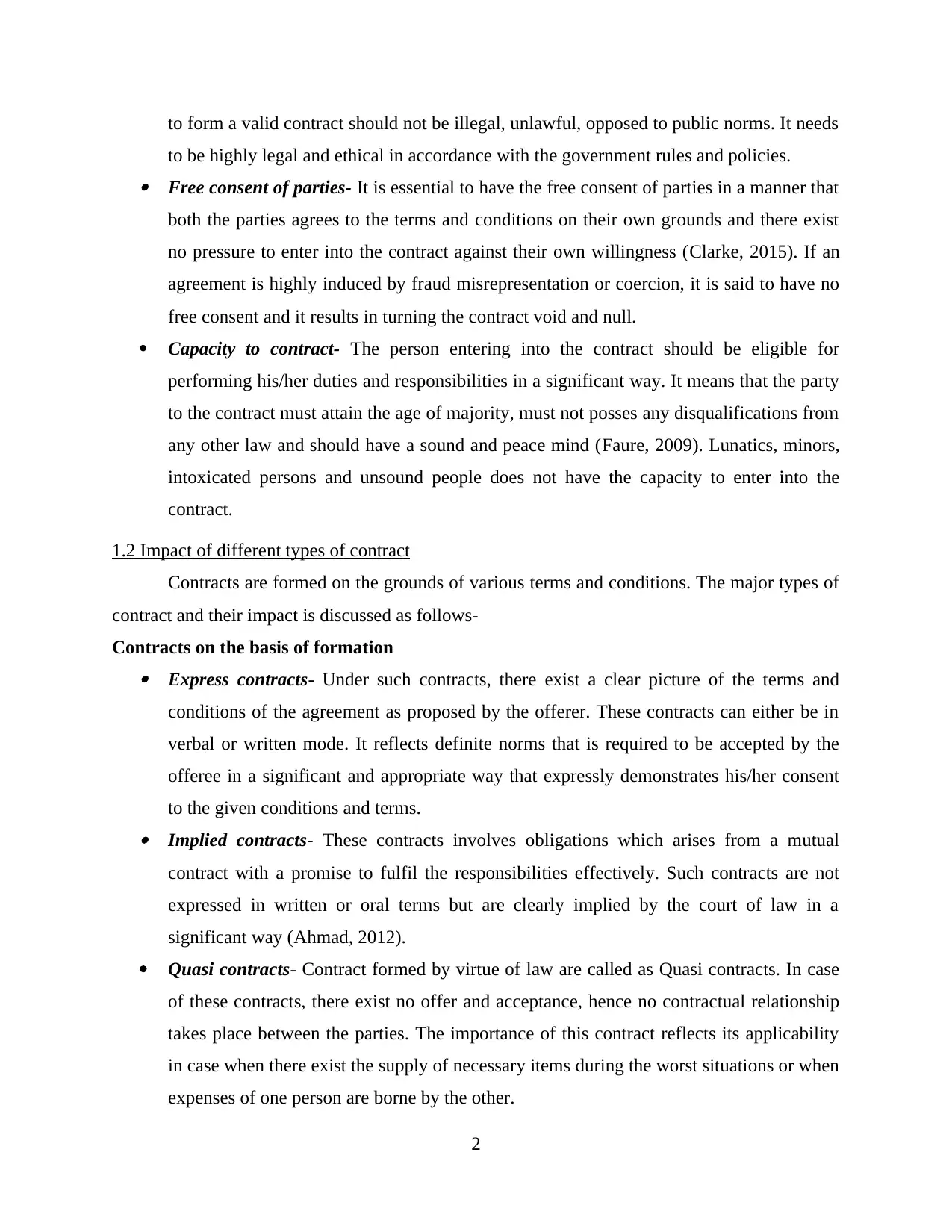
to form a valid contract should not be illegal, unlawful, opposed to public norms. It needs
to be highly legal and ethical in accordance with the government rules and policies. Free consent of parties- It is essential to have the free consent of parties in a manner that
both the parties agrees to the terms and conditions on their own grounds and there exist
no pressure to enter into the contract against their own willingness (Clarke, 2015). If an
agreement is highly induced by fraud misrepresentation or coercion, it is said to have no
free consent and it results in turning the contract void and null.
Capacity to contract- The person entering into the contract should be eligible for
performing his/her duties and responsibilities in a significant way. It means that the party
to the contract must attain the age of majority, must not posses any disqualifications from
any other law and should have a sound and peace mind (Faure, 2009). Lunatics, minors,
intoxicated persons and unsound people does not have the capacity to enter into the
contract.
1.2 Impact of different types of contract
Contracts are formed on the grounds of various terms and conditions. The major types of
contract and their impact is discussed as follows-
Contracts on the basis of formation Express contracts- Under such contracts, there exist a clear picture of the terms and
conditions of the agreement as proposed by the offerer. These contracts can either be in
verbal or written mode. It reflects definite norms that is required to be accepted by the
offeree in a significant and appropriate way that expressly demonstrates his/her consent
to the given conditions and terms. Implied contracts- These contracts involves obligations which arises from a mutual
contract with a promise to fulfil the responsibilities effectively. Such contracts are not
expressed in written or oral terms but are clearly implied by the court of law in a
significant way (Ahmad, 2012).
Quasi contracts- Contract formed by virtue of law are called as Quasi contracts. In case
of these contracts, there exist no offer and acceptance, hence no contractual relationship
takes place between the parties. The importance of this contract reflects its applicability
in case when there exist the supply of necessary items during the worst situations or when
expenses of one person are borne by the other.
2
to be highly legal and ethical in accordance with the government rules and policies. Free consent of parties- It is essential to have the free consent of parties in a manner that
both the parties agrees to the terms and conditions on their own grounds and there exist
no pressure to enter into the contract against their own willingness (Clarke, 2015). If an
agreement is highly induced by fraud misrepresentation or coercion, it is said to have no
free consent and it results in turning the contract void and null.
Capacity to contract- The person entering into the contract should be eligible for
performing his/her duties and responsibilities in a significant way. It means that the party
to the contract must attain the age of majority, must not posses any disqualifications from
any other law and should have a sound and peace mind (Faure, 2009). Lunatics, minors,
intoxicated persons and unsound people does not have the capacity to enter into the
contract.
1.2 Impact of different types of contract
Contracts are formed on the grounds of various terms and conditions. The major types of
contract and their impact is discussed as follows-
Contracts on the basis of formation Express contracts- Under such contracts, there exist a clear picture of the terms and
conditions of the agreement as proposed by the offerer. These contracts can either be in
verbal or written mode. It reflects definite norms that is required to be accepted by the
offeree in a significant and appropriate way that expressly demonstrates his/her consent
to the given conditions and terms. Implied contracts- These contracts involves obligations which arises from a mutual
contract with a promise to fulfil the responsibilities effectively. Such contracts are not
expressed in written or oral terms but are clearly implied by the court of law in a
significant way (Ahmad, 2012).
Quasi contracts- Contract formed by virtue of law are called as Quasi contracts. In case
of these contracts, there exist no offer and acceptance, hence no contractual relationship
takes place between the parties. The importance of this contract reflects its applicability
in case when there exist the supply of necessary items during the worst situations or when
expenses of one person are borne by the other.
2
Paraphrase This Document
Need a fresh take? Get an instant paraphrase of this document with our AI Paraphraser
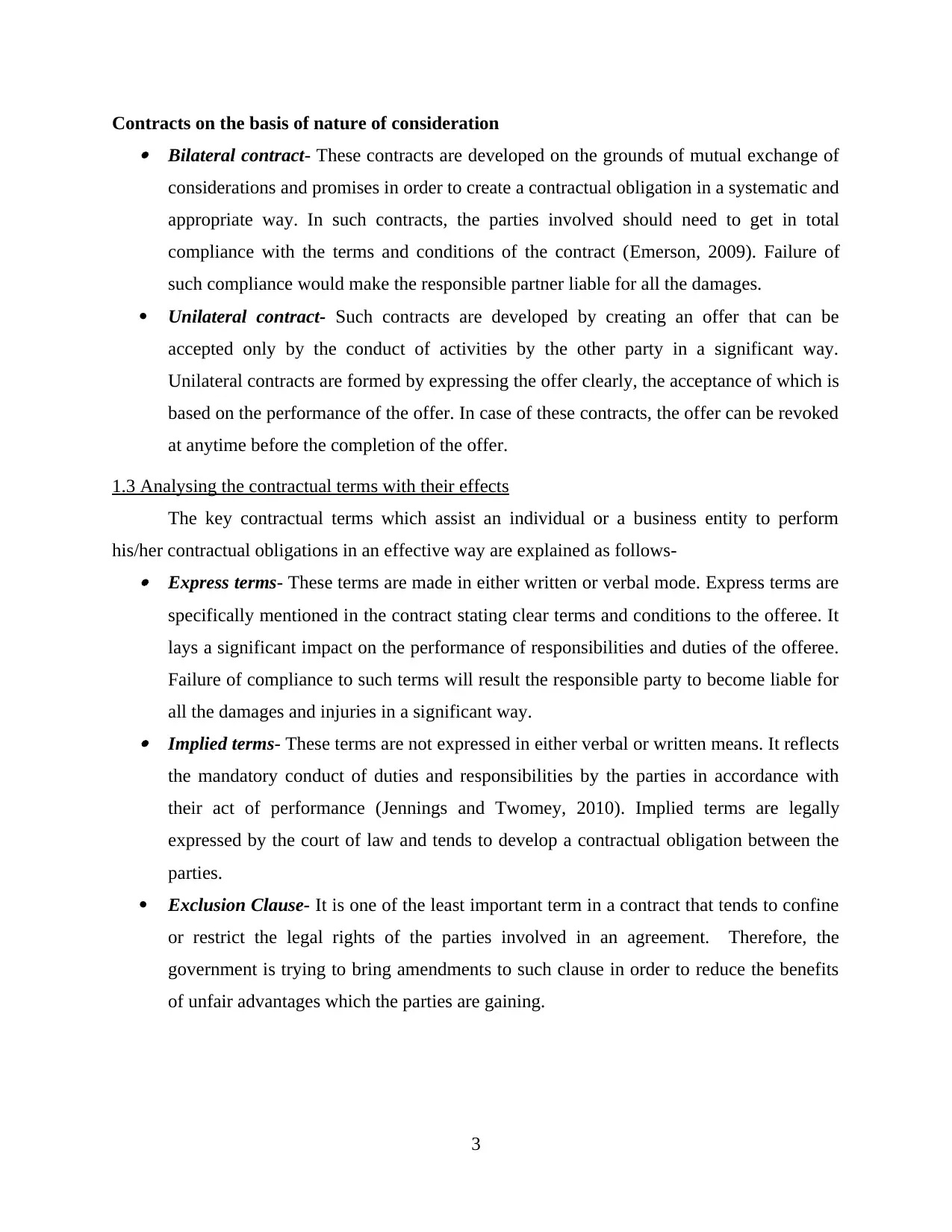
Contracts on the basis of nature of consideration Bilateral contract- These contracts are developed on the grounds of mutual exchange of
considerations and promises in order to create a contractual obligation in a systematic and
appropriate way. In such contracts, the parties involved should need to get in total
compliance with the terms and conditions of the contract (Emerson, 2009). Failure of
such compliance would make the responsible partner liable for all the damages.
Unilateral contract- Such contracts are developed by creating an offer that can be
accepted only by the conduct of activities by the other party in a significant way.
Unilateral contracts are formed by expressing the offer clearly, the acceptance of which is
based on the performance of the offer. In case of these contracts, the offer can be revoked
at anytime before the completion of the offer.
1.3 Analysing the contractual terms with their effects
The key contractual terms which assist an individual or a business entity to perform
his/her contractual obligations in an effective way are explained as follows- Express terms- These terms are made in either written or verbal mode. Express terms are
specifically mentioned in the contract stating clear terms and conditions to the offeree. It
lays a significant impact on the performance of responsibilities and duties of the offeree.
Failure of compliance to such terms will result the responsible party to become liable for
all the damages and injuries in a significant way. Implied terms- These terms are not expressed in either verbal or written means. It reflects
the mandatory conduct of duties and responsibilities by the parties in accordance with
their act of performance (Jennings and Twomey, 2010). Implied terms are legally
expressed by the court of law and tends to develop a contractual obligation between the
parties.
Exclusion Clause- It is one of the least important term in a contract that tends to confine
or restrict the legal rights of the parties involved in an agreement. Therefore, the
government is trying to bring amendments to such clause in order to reduce the benefits
of unfair advantages which the parties are gaining.
3
considerations and promises in order to create a contractual obligation in a systematic and
appropriate way. In such contracts, the parties involved should need to get in total
compliance with the terms and conditions of the contract (Emerson, 2009). Failure of
such compliance would make the responsible partner liable for all the damages.
Unilateral contract- Such contracts are developed by creating an offer that can be
accepted only by the conduct of activities by the other party in a significant way.
Unilateral contracts are formed by expressing the offer clearly, the acceptance of which is
based on the performance of the offer. In case of these contracts, the offer can be revoked
at anytime before the completion of the offer.
1.3 Analysing the contractual terms with their effects
The key contractual terms which assist an individual or a business entity to perform
his/her contractual obligations in an effective way are explained as follows- Express terms- These terms are made in either written or verbal mode. Express terms are
specifically mentioned in the contract stating clear terms and conditions to the offeree. It
lays a significant impact on the performance of responsibilities and duties of the offeree.
Failure of compliance to such terms will result the responsible party to become liable for
all the damages and injuries in a significant way. Implied terms- These terms are not expressed in either verbal or written means. It reflects
the mandatory conduct of duties and responsibilities by the parties in accordance with
their act of performance (Jennings and Twomey, 2010). Implied terms are legally
expressed by the court of law and tends to develop a contractual obligation between the
parties.
Exclusion Clause- It is one of the least important term in a contract that tends to confine
or restrict the legal rights of the parties involved in an agreement. Therefore, the
government is trying to bring amendments to such clause in order to reduce the benefits
of unfair advantages which the parties are gaining.
3
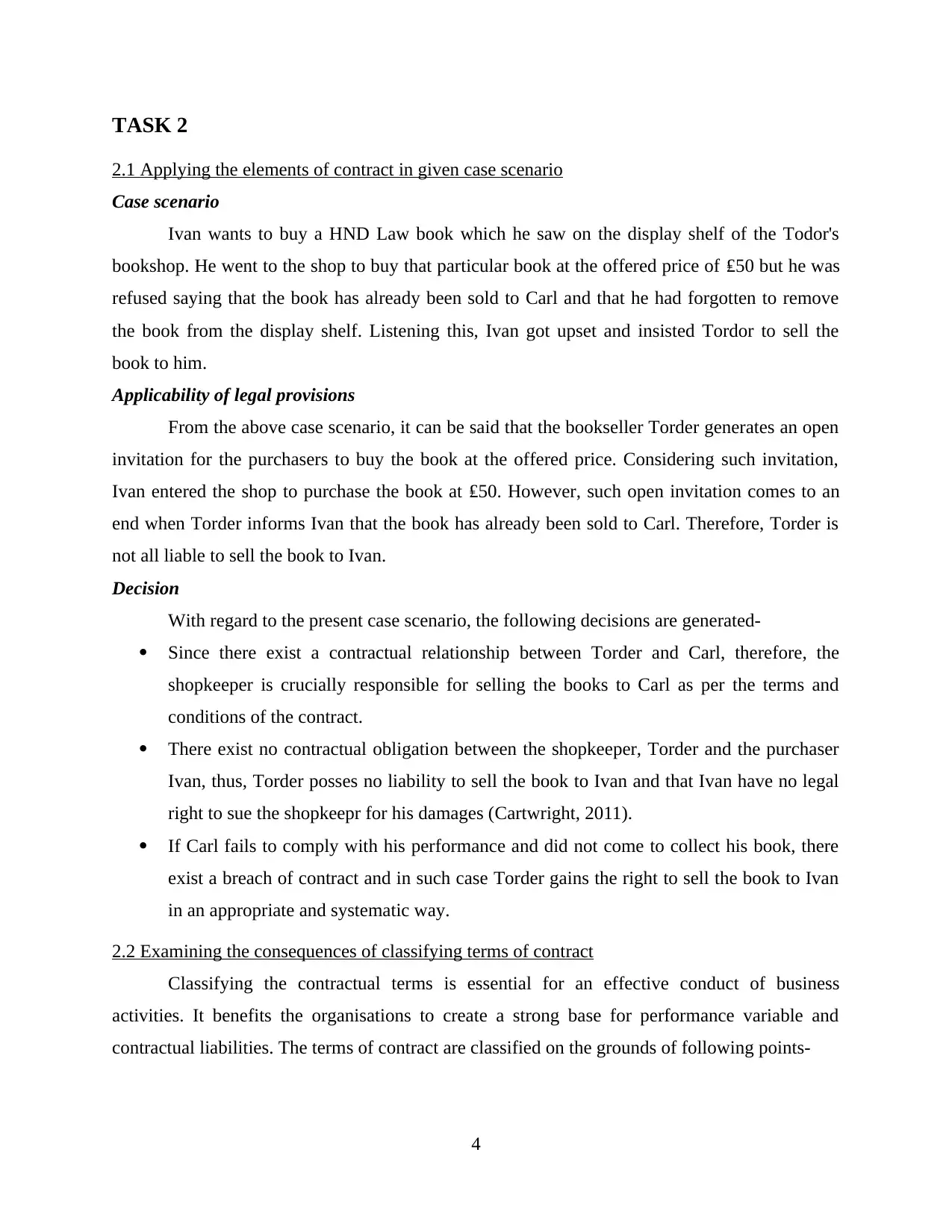
TASK 2
2.1 Applying the elements of contract in given case scenario
Case scenario
Ivan wants to buy a HND Law book which he saw on the display shelf of the Todor's
bookshop. He went to the shop to buy that particular book at the offered price of ₤50 but he was
refused saying that the book has already been sold to Carl and that he had forgotten to remove
the book from the display shelf. Listening this, Ivan got upset and insisted Tordor to sell the
book to him.
Applicability of legal provisions
From the above case scenario, it can be said that the bookseller Torder generates an open
invitation for the purchasers to buy the book at the offered price. Considering such invitation,
Ivan entered the shop to purchase the book at ₤50. However, such open invitation comes to an
end when Torder informs Ivan that the book has already been sold to Carl. Therefore, Torder is
not all liable to sell the book to Ivan.
Decision
With regard to the present case scenario, the following decisions are generated-
Since there exist a contractual relationship between Torder and Carl, therefore, the
shopkeeper is crucially responsible for selling the books to Carl as per the terms and
conditions of the contract.
There exist no contractual obligation between the shopkeeper, Torder and the purchaser
Ivan, thus, Torder posses no liability to sell the book to Ivan and that Ivan have no legal
right to sue the shopkeepr for his damages (Cartwright, 2011).
If Carl fails to comply with his performance and did not come to collect his book, there
exist a breach of contract and in such case Torder gains the right to sell the book to Ivan
in an appropriate and systematic way.
2.2 Examining the consequences of classifying terms of contract
Classifying the contractual terms is essential for an effective conduct of business
activities. It benefits the organisations to create a strong base for performance variable and
contractual liabilities. The terms of contract are classified on the grounds of following points-
4
2.1 Applying the elements of contract in given case scenario
Case scenario
Ivan wants to buy a HND Law book which he saw on the display shelf of the Todor's
bookshop. He went to the shop to buy that particular book at the offered price of ₤50 but he was
refused saying that the book has already been sold to Carl and that he had forgotten to remove
the book from the display shelf. Listening this, Ivan got upset and insisted Tordor to sell the
book to him.
Applicability of legal provisions
From the above case scenario, it can be said that the bookseller Torder generates an open
invitation for the purchasers to buy the book at the offered price. Considering such invitation,
Ivan entered the shop to purchase the book at ₤50. However, such open invitation comes to an
end when Torder informs Ivan that the book has already been sold to Carl. Therefore, Torder is
not all liable to sell the book to Ivan.
Decision
With regard to the present case scenario, the following decisions are generated-
Since there exist a contractual relationship between Torder and Carl, therefore, the
shopkeeper is crucially responsible for selling the books to Carl as per the terms and
conditions of the contract.
There exist no contractual obligation between the shopkeeper, Torder and the purchaser
Ivan, thus, Torder posses no liability to sell the book to Ivan and that Ivan have no legal
right to sue the shopkeepr for his damages (Cartwright, 2011).
If Carl fails to comply with his performance and did not come to collect his book, there
exist a breach of contract and in such case Torder gains the right to sell the book to Ivan
in an appropriate and systematic way.
2.2 Examining the consequences of classifying terms of contract
Classifying the contractual terms is essential for an effective conduct of business
activities. It benefits the organisations to create a strong base for performance variable and
contractual liabilities. The terms of contract are classified on the grounds of following points-
4
⊘ This is a preview!⊘
Do you want full access?
Subscribe today to unlock all pages.

Trusted by 1+ million students worldwide
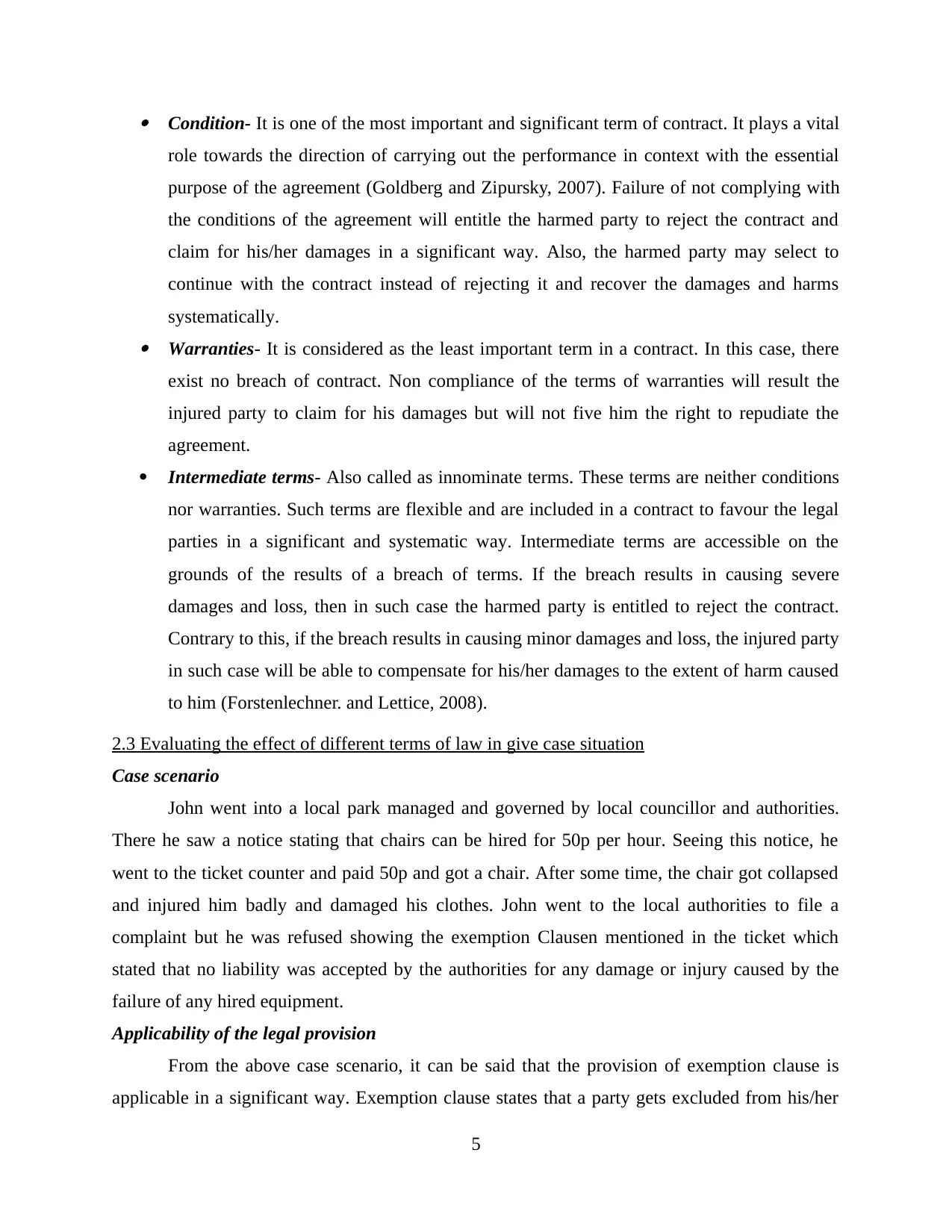
Condition- It is one of the most important and significant term of contract. It plays a vital
role towards the direction of carrying out the performance in context with the essential
purpose of the agreement (Goldberg and Zipursky, 2007). Failure of not complying with
the conditions of the agreement will entitle the harmed party to reject the contract and
claim for his/her damages in a significant way. Also, the harmed party may select to
continue with the contract instead of rejecting it and recover the damages and harms
systematically. Warranties- It is considered as the least important term in a contract. In this case, there
exist no breach of contract. Non compliance of the terms of warranties will result the
injured party to claim for his damages but will not five him the right to repudiate the
agreement.
Intermediate terms- Also called as innominate terms. These terms are neither conditions
nor warranties. Such terms are flexible and are included in a contract to favour the legal
parties in a significant and systematic way. Intermediate terms are accessible on the
grounds of the results of a breach of terms. If the breach results in causing severe
damages and loss, then in such case the harmed party is entitled to reject the contract.
Contrary to this, if the breach results in causing minor damages and loss, the injured party
in such case will be able to compensate for his/her damages to the extent of harm caused
to him (Forstenlechner. and Lettice, 2008).
2.3 Evaluating the effect of different terms of law in give case situation
Case scenario
John went into a local park managed and governed by local councillor and authorities.
There he saw a notice stating that chairs can be hired for 50p per hour. Seeing this notice, he
went to the ticket counter and paid 50p and got a chair. After some time, the chair got collapsed
and injured him badly and damaged his clothes. John went to the local authorities to file a
complaint but he was refused showing the exemption Clausen mentioned in the ticket which
stated that no liability was accepted by the authorities for any damage or injury caused by the
failure of any hired equipment.
Applicability of the legal provision
From the above case scenario, it can be said that the provision of exemption clause is
applicable in a significant way. Exemption clause states that a party gets excluded from his/her
5
role towards the direction of carrying out the performance in context with the essential
purpose of the agreement (Goldberg and Zipursky, 2007). Failure of not complying with
the conditions of the agreement will entitle the harmed party to reject the contract and
claim for his/her damages in a significant way. Also, the harmed party may select to
continue with the contract instead of rejecting it and recover the damages and harms
systematically. Warranties- It is considered as the least important term in a contract. In this case, there
exist no breach of contract. Non compliance of the terms of warranties will result the
injured party to claim for his damages but will not five him the right to repudiate the
agreement.
Intermediate terms- Also called as innominate terms. These terms are neither conditions
nor warranties. Such terms are flexible and are included in a contract to favour the legal
parties in a significant and systematic way. Intermediate terms are accessible on the
grounds of the results of a breach of terms. If the breach results in causing severe
damages and loss, then in such case the harmed party is entitled to reject the contract.
Contrary to this, if the breach results in causing minor damages and loss, the injured party
in such case will be able to compensate for his/her damages to the extent of harm caused
to him (Forstenlechner. and Lettice, 2008).
2.3 Evaluating the effect of different terms of law in give case situation
Case scenario
John went into a local park managed and governed by local councillor and authorities.
There he saw a notice stating that chairs can be hired for 50p per hour. Seeing this notice, he
went to the ticket counter and paid 50p and got a chair. After some time, the chair got collapsed
and injured him badly and damaged his clothes. John went to the local authorities to file a
complaint but he was refused showing the exemption Clausen mentioned in the ticket which
stated that no liability was accepted by the authorities for any damage or injury caused by the
failure of any hired equipment.
Applicability of the legal provision
From the above case scenario, it can be said that the provision of exemption clause is
applicable in a significant way. Exemption clause states that a party gets excluded from his/her
5
Paraphrase This Document
Need a fresh take? Get an instant paraphrase of this document with our AI Paraphraser
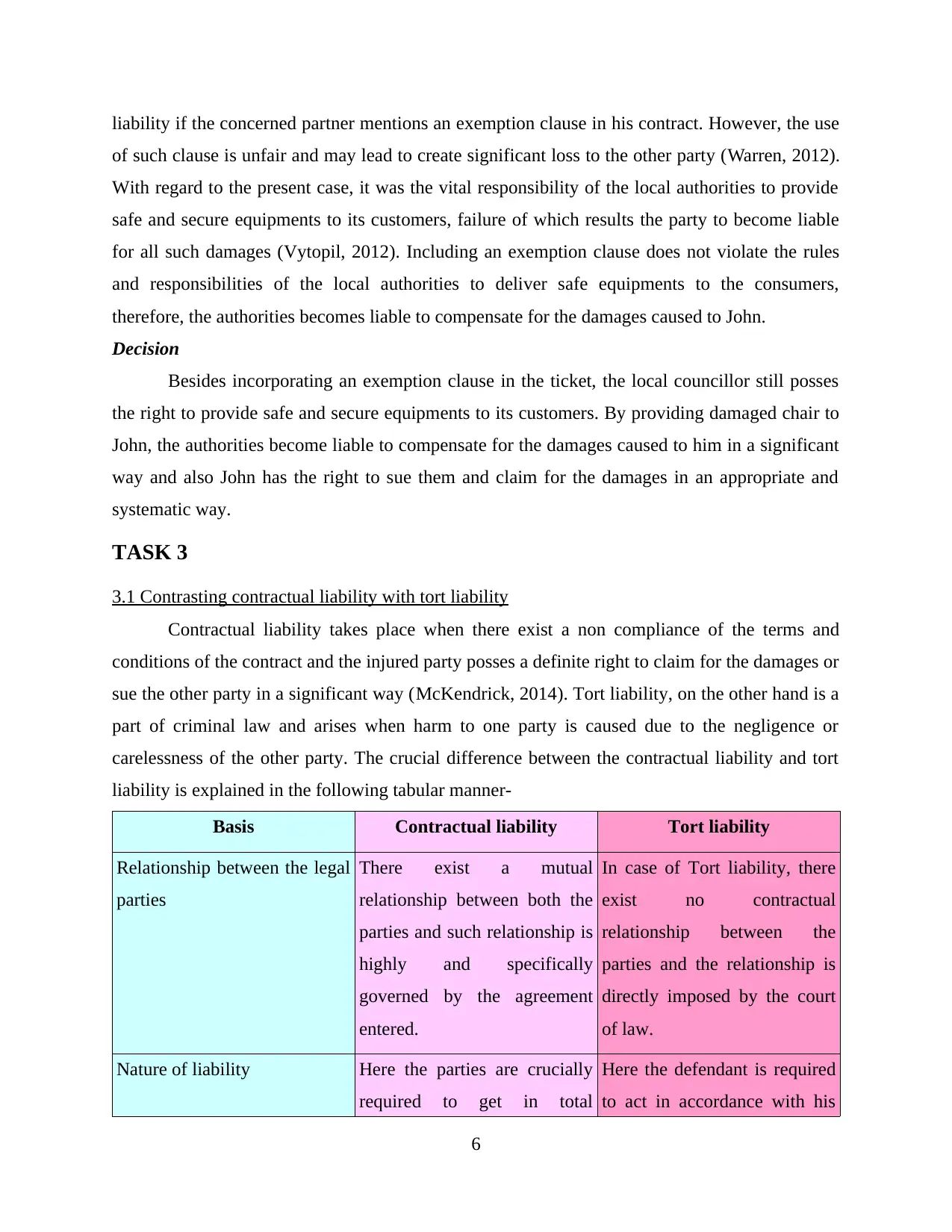
liability if the concerned partner mentions an exemption clause in his contract. However, the use
of such clause is unfair and may lead to create significant loss to the other party (Warren, 2012).
With regard to the present case, it was the vital responsibility of the local authorities to provide
safe and secure equipments to its customers, failure of which results the party to become liable
for all such damages (Vytopil, 2012). Including an exemption clause does not violate the rules
and responsibilities of the local authorities to deliver safe equipments to the consumers,
therefore, the authorities becomes liable to compensate for the damages caused to John.
Decision
Besides incorporating an exemption clause in the ticket, the local councillor still posses
the right to provide safe and secure equipments to its customers. By providing damaged chair to
John, the authorities become liable to compensate for the damages caused to him in a significant
way and also John has the right to sue them and claim for the damages in an appropriate and
systematic way.
TASK 3
3.1 Contrasting contractual liability with tort liability
Contractual liability takes place when there exist a non compliance of the terms and
conditions of the contract and the injured party posses a definite right to claim for the damages or
sue the other party in a significant way (McKendrick, 2014). Tort liability, on the other hand is a
part of criminal law and arises when harm to one party is caused due to the negligence or
carelessness of the other party. The crucial difference between the contractual liability and tort
liability is explained in the following tabular manner-
Basis Contractual liability Tort liability
Relationship between the legal
parties
There exist a mutual
relationship between both the
parties and such relationship is
highly and specifically
governed by the agreement
entered.
In case of Tort liability, there
exist no contractual
relationship between the
parties and the relationship is
directly imposed by the court
of law.
Nature of liability Here the parties are crucially
required to get in total
Here the defendant is required
to act in accordance with his
6
of such clause is unfair and may lead to create significant loss to the other party (Warren, 2012).
With regard to the present case, it was the vital responsibility of the local authorities to provide
safe and secure equipments to its customers, failure of which results the party to become liable
for all such damages (Vytopil, 2012). Including an exemption clause does not violate the rules
and responsibilities of the local authorities to deliver safe equipments to the consumers,
therefore, the authorities becomes liable to compensate for the damages caused to John.
Decision
Besides incorporating an exemption clause in the ticket, the local councillor still posses
the right to provide safe and secure equipments to its customers. By providing damaged chair to
John, the authorities become liable to compensate for the damages caused to him in a significant
way and also John has the right to sue them and claim for the damages in an appropriate and
systematic way.
TASK 3
3.1 Contrasting contractual liability with tort liability
Contractual liability takes place when there exist a non compliance of the terms and
conditions of the contract and the injured party posses a definite right to claim for the damages or
sue the other party in a significant way (McKendrick, 2014). Tort liability, on the other hand is a
part of criminal law and arises when harm to one party is caused due to the negligence or
carelessness of the other party. The crucial difference between the contractual liability and tort
liability is explained in the following tabular manner-
Basis Contractual liability Tort liability
Relationship between the legal
parties
There exist a mutual
relationship between both the
parties and such relationship is
highly and specifically
governed by the agreement
entered.
In case of Tort liability, there
exist no contractual
relationship between the
parties and the relationship is
directly imposed by the court
of law.
Nature of liability Here the parties are crucially
required to get in total
Here the defendant is required
to act in accordance with his
6
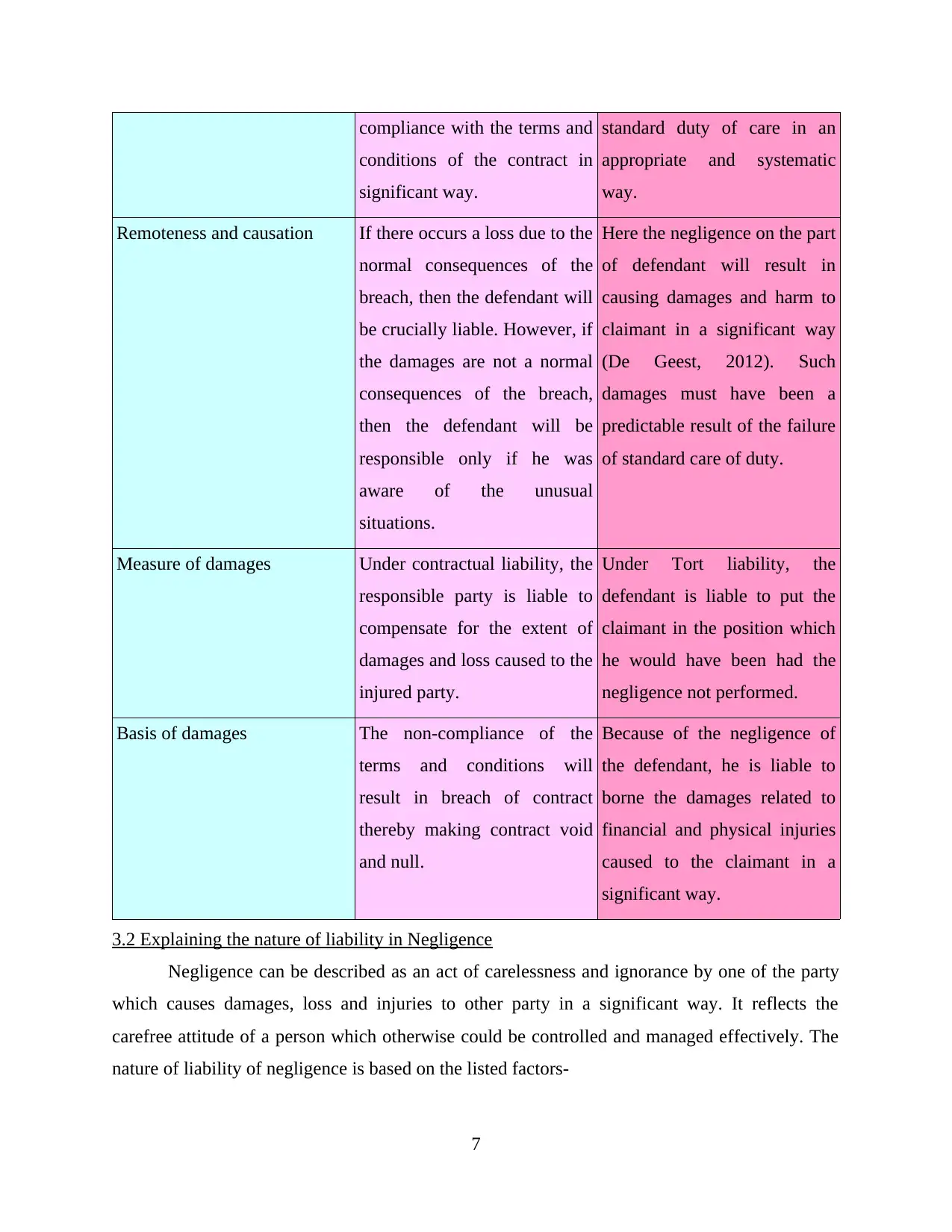
compliance with the terms and
conditions of the contract in
significant way.
standard duty of care in an
appropriate and systematic
way.
Remoteness and causation If there occurs a loss due to the
normal consequences of the
breach, then the defendant will
be crucially liable. However, if
the damages are not a normal
consequences of the breach,
then the defendant will be
responsible only if he was
aware of the unusual
situations.
Here the negligence on the part
of defendant will result in
causing damages and harm to
claimant in a significant way
(De Geest, 2012). Such
damages must have been a
predictable result of the failure
of standard care of duty.
Measure of damages Under contractual liability, the
responsible party is liable to
compensate for the extent of
damages and loss caused to the
injured party.
Under Tort liability, the
defendant is liable to put the
claimant in the position which
he would have been had the
negligence not performed.
Basis of damages The non-compliance of the
terms and conditions will
result in breach of contract
thereby making contract void
and null.
Because of the negligence of
the defendant, he is liable to
borne the damages related to
financial and physical injuries
caused to the claimant in a
significant way.
3.2 Explaining the nature of liability in Negligence
Negligence can be described as an act of carelessness and ignorance by one of the party
which causes damages, loss and injuries to other party in a significant way. It reflects the
carefree attitude of a person which otherwise could be controlled and managed effectively. The
nature of liability of negligence is based on the listed factors-
7
conditions of the contract in
significant way.
standard duty of care in an
appropriate and systematic
way.
Remoteness and causation If there occurs a loss due to the
normal consequences of the
breach, then the defendant will
be crucially liable. However, if
the damages are not a normal
consequences of the breach,
then the defendant will be
responsible only if he was
aware of the unusual
situations.
Here the negligence on the part
of defendant will result in
causing damages and harm to
claimant in a significant way
(De Geest, 2012). Such
damages must have been a
predictable result of the failure
of standard care of duty.
Measure of damages Under contractual liability, the
responsible party is liable to
compensate for the extent of
damages and loss caused to the
injured party.
Under Tort liability, the
defendant is liable to put the
claimant in the position which
he would have been had the
negligence not performed.
Basis of damages The non-compliance of the
terms and conditions will
result in breach of contract
thereby making contract void
and null.
Because of the negligence of
the defendant, he is liable to
borne the damages related to
financial and physical injuries
caused to the claimant in a
significant way.
3.2 Explaining the nature of liability in Negligence
Negligence can be described as an act of carelessness and ignorance by one of the party
which causes damages, loss and injuries to other party in a significant way. It reflects the
carefree attitude of a person which otherwise could be controlled and managed effectively. The
nature of liability of negligence is based on the listed factors-
7
⊘ This is a preview!⊘
Do you want full access?
Subscribe today to unlock all pages.

Trusted by 1+ million students worldwide
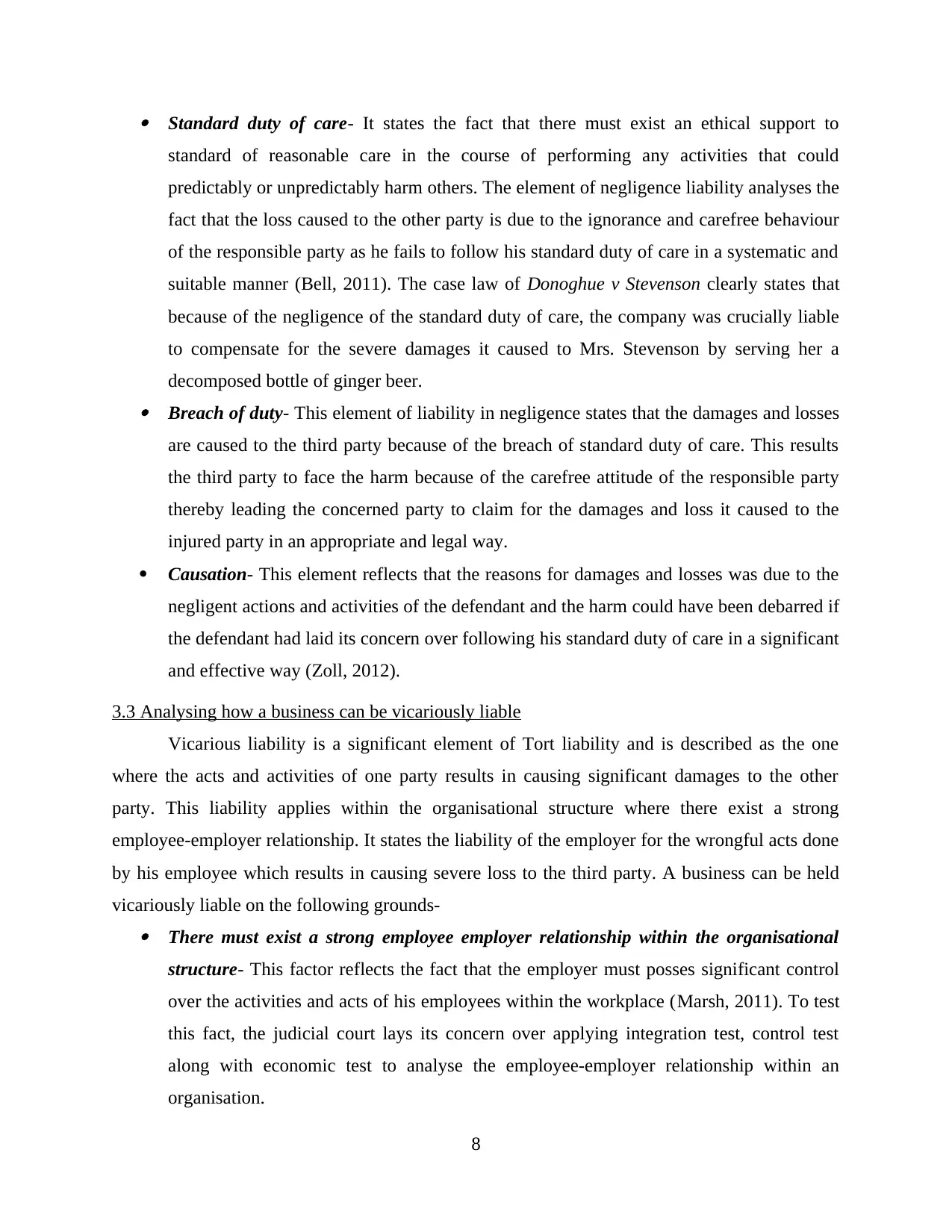
Standard duty of care- It states the fact that there must exist an ethical support to
standard of reasonable care in the course of performing any activities that could
predictably or unpredictably harm others. The element of negligence liability analyses the
fact that the loss caused to the other party is due to the ignorance and carefree behaviour
of the responsible party as he fails to follow his standard duty of care in a systematic and
suitable manner (Bell, 2011). The case law of Donoghue v Stevenson clearly states that
because of the negligence of the standard duty of care, the company was crucially liable
to compensate for the severe damages it caused to Mrs. Stevenson by serving her a
decomposed bottle of ginger beer. Breach of duty- This element of liability in negligence states that the damages and losses
are caused to the third party because of the breach of standard duty of care. This results
the third party to face the harm because of the carefree attitude of the responsible party
thereby leading the concerned party to claim for the damages and loss it caused to the
injured party in an appropriate and legal way.
Causation- This element reflects that the reasons for damages and losses was due to the
negligent actions and activities of the defendant and the harm could have been debarred if
the defendant had laid its concern over following his standard duty of care in a significant
and effective way (Zoll, 2012).
3.3 Analysing how a business can be vicariously liable
Vicarious liability is a significant element of Tort liability and is described as the one
where the acts and activities of one party results in causing significant damages to the other
party. This liability applies within the organisational structure where there exist a strong
employee-employer relationship. It states the liability of the employer for the wrongful acts done
by his employee which results in causing severe loss to the third party. A business can be held
vicariously liable on the following grounds- There must exist a strong employee employer relationship within the organisational
structure- This factor reflects the fact that the employer must posses significant control
over the activities and acts of his employees within the workplace (Marsh, 2011). To test
this fact, the judicial court lays its concern over applying integration test, control test
along with economic test to analyse the employee-employer relationship within an
organisation.
8
standard of reasonable care in the course of performing any activities that could
predictably or unpredictably harm others. The element of negligence liability analyses the
fact that the loss caused to the other party is due to the ignorance and carefree behaviour
of the responsible party as he fails to follow his standard duty of care in a systematic and
suitable manner (Bell, 2011). The case law of Donoghue v Stevenson clearly states that
because of the negligence of the standard duty of care, the company was crucially liable
to compensate for the severe damages it caused to Mrs. Stevenson by serving her a
decomposed bottle of ginger beer. Breach of duty- This element of liability in negligence states that the damages and losses
are caused to the third party because of the breach of standard duty of care. This results
the third party to face the harm because of the carefree attitude of the responsible party
thereby leading the concerned party to claim for the damages and loss it caused to the
injured party in an appropriate and legal way.
Causation- This element reflects that the reasons for damages and losses was due to the
negligent actions and activities of the defendant and the harm could have been debarred if
the defendant had laid its concern over following his standard duty of care in a significant
and effective way (Zoll, 2012).
3.3 Analysing how a business can be vicariously liable
Vicarious liability is a significant element of Tort liability and is described as the one
where the acts and activities of one party results in causing significant damages to the other
party. This liability applies within the organisational structure where there exist a strong
employee-employer relationship. It states the liability of the employer for the wrongful acts done
by his employee which results in causing severe loss to the third party. A business can be held
vicariously liable on the following grounds- There must exist a strong employee employer relationship within the organisational
structure- This factor reflects the fact that the employer must posses significant control
over the activities and acts of his employees within the workplace (Marsh, 2011). To test
this fact, the judicial court lays its concern over applying integration test, control test
along with economic test to analyse the employee-employer relationship within an
organisation.
8
Paraphrase This Document
Need a fresh take? Get an instant paraphrase of this document with our AI Paraphraser
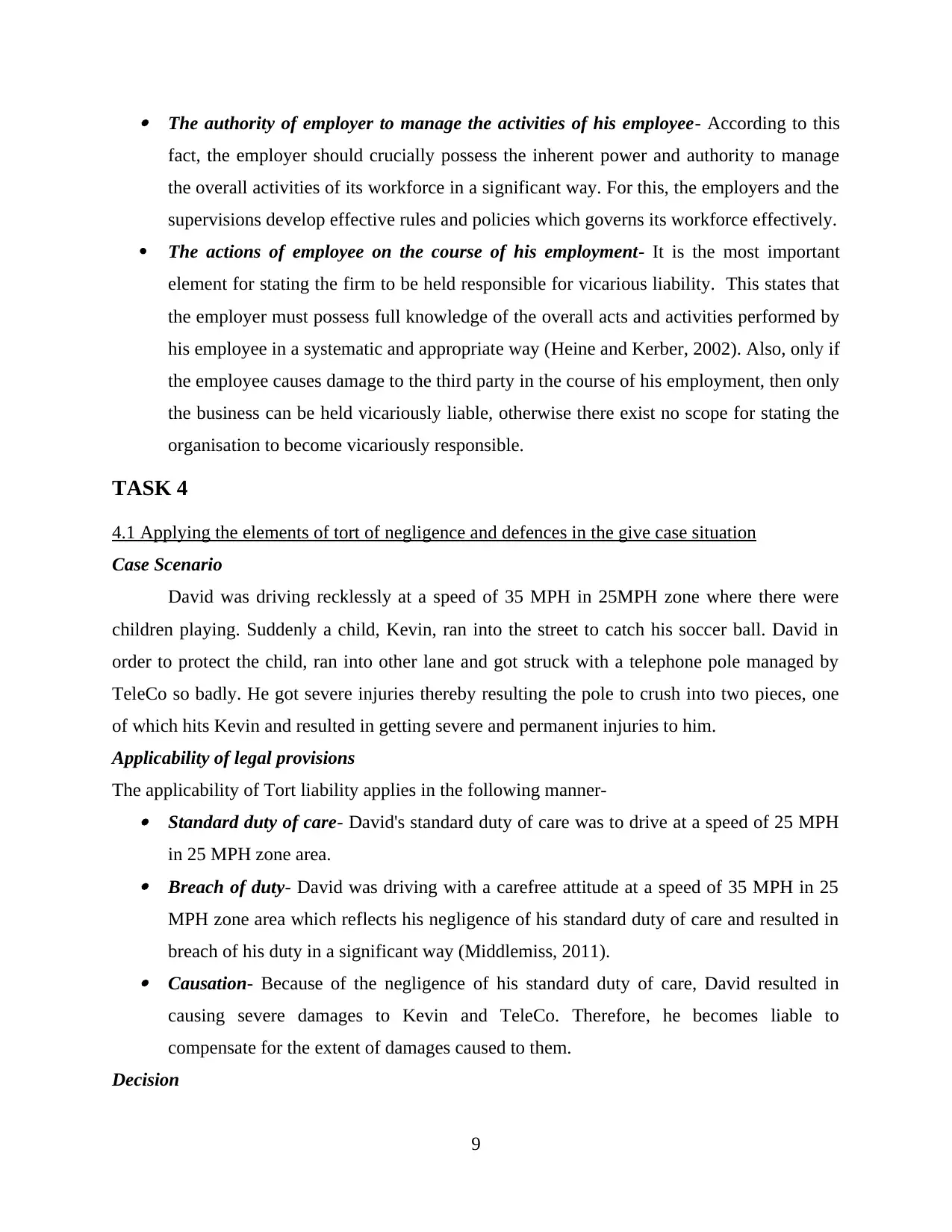
The authority of employer to manage the activities of his employee- According to this
fact, the employer should crucially possess the inherent power and authority to manage
the overall activities of its workforce in a significant way. For this, the employers and the
supervisions develop effective rules and policies which governs its workforce effectively.
The actions of employee on the course of his employment- It is the most important
element for stating the firm to be held responsible for vicarious liability. This states that
the employer must possess full knowledge of the overall acts and activities performed by
his employee in a systematic and appropriate way (Heine and Kerber, 2002). Also, only if
the employee causes damage to the third party in the course of his employment, then only
the business can be held vicariously liable, otherwise there exist no scope for stating the
organisation to become vicariously responsible.
TASK 4
4.1 Applying the elements of tort of negligence and defences in the give case situation
Case Scenario
David was driving recklessly at a speed of 35 MPH in 25MPH zone where there were
children playing. Suddenly a child, Kevin, ran into the street to catch his soccer ball. David in
order to protect the child, ran into other lane and got struck with a telephone pole managed by
TeleCo so badly. He got severe injuries thereby resulting the pole to crush into two pieces, one
of which hits Kevin and resulted in getting severe and permanent injuries to him.
Applicability of legal provisions
The applicability of Tort liability applies in the following manner- Standard duty of care- David's standard duty of care was to drive at a speed of 25 MPH
in 25 MPH zone area. Breach of duty- David was driving with a carefree attitude at a speed of 35 MPH in 25
MPH zone area which reflects his negligence of his standard duty of care and resulted in
breach of his duty in a significant way (Middlemiss, 2011). Causation- Because of the negligence of his standard duty of care, David resulted in
causing severe damages to Kevin and TeleCo. Therefore, he becomes liable to
compensate for the extent of damages caused to them.
Decision
9
fact, the employer should crucially possess the inherent power and authority to manage
the overall activities of its workforce in a significant way. For this, the employers and the
supervisions develop effective rules and policies which governs its workforce effectively.
The actions of employee on the course of his employment- It is the most important
element for stating the firm to be held responsible for vicarious liability. This states that
the employer must possess full knowledge of the overall acts and activities performed by
his employee in a systematic and appropriate way (Heine and Kerber, 2002). Also, only if
the employee causes damage to the third party in the course of his employment, then only
the business can be held vicariously liable, otherwise there exist no scope for stating the
organisation to become vicariously responsible.
TASK 4
4.1 Applying the elements of tort of negligence and defences in the give case situation
Case Scenario
David was driving recklessly at a speed of 35 MPH in 25MPH zone where there were
children playing. Suddenly a child, Kevin, ran into the street to catch his soccer ball. David in
order to protect the child, ran into other lane and got struck with a telephone pole managed by
TeleCo so badly. He got severe injuries thereby resulting the pole to crush into two pieces, one
of which hits Kevin and resulted in getting severe and permanent injuries to him.
Applicability of legal provisions
The applicability of Tort liability applies in the following manner- Standard duty of care- David's standard duty of care was to drive at a speed of 25 MPH
in 25 MPH zone area. Breach of duty- David was driving with a carefree attitude at a speed of 35 MPH in 25
MPH zone area which reflects his negligence of his standard duty of care and resulted in
breach of his duty in a significant way (Middlemiss, 2011). Causation- Because of the negligence of his standard duty of care, David resulted in
causing severe damages to Kevin and TeleCo. Therefore, he becomes liable to
compensate for the extent of damages caused to them.
Decision
9
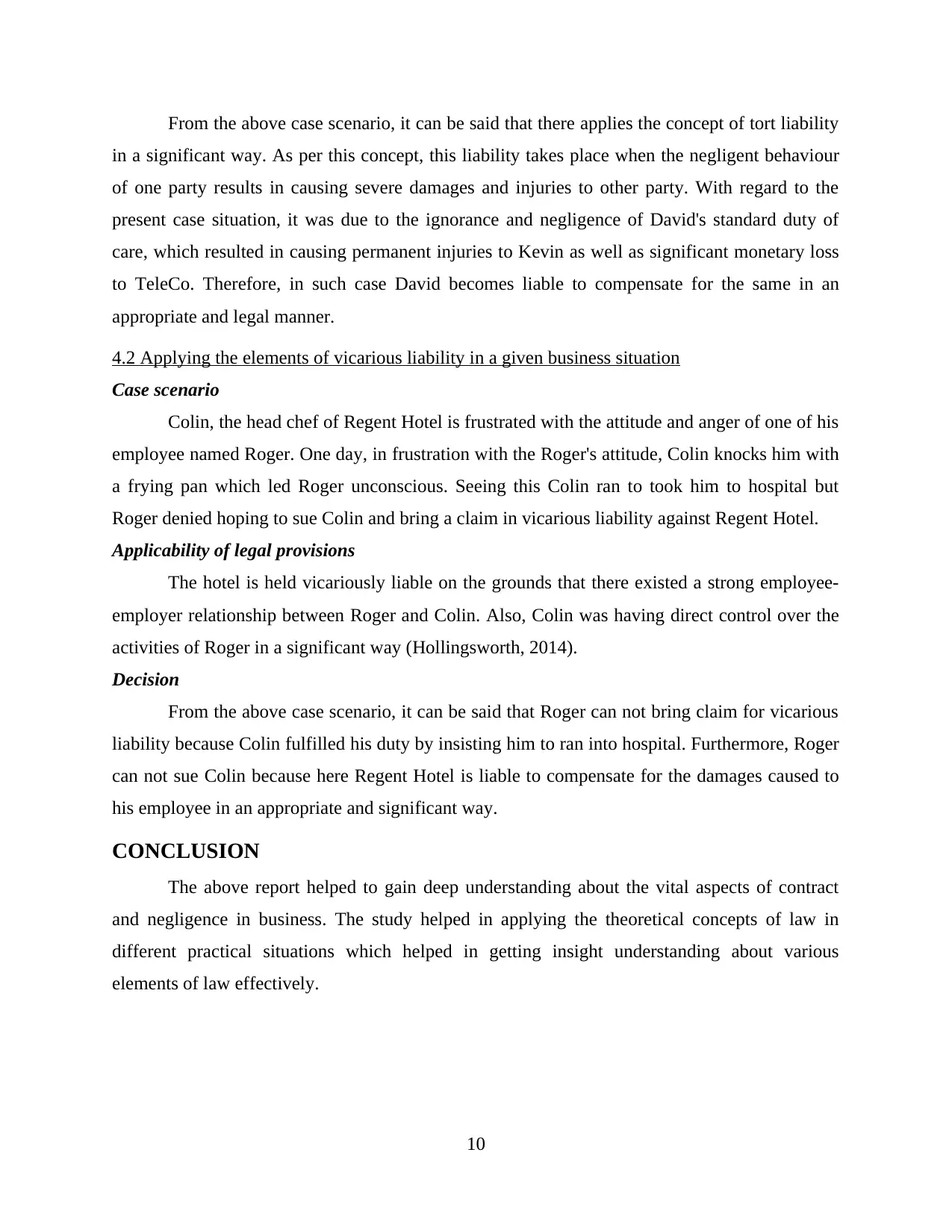
From the above case scenario, it can be said that there applies the concept of tort liability
in a significant way. As per this concept, this liability takes place when the negligent behaviour
of one party results in causing severe damages and injuries to other party. With regard to the
present case situation, it was due to the ignorance and negligence of David's standard duty of
care, which resulted in causing permanent injuries to Kevin as well as significant monetary loss
to TeleCo. Therefore, in such case David becomes liable to compensate for the same in an
appropriate and legal manner.
4.2 Applying the elements of vicarious liability in a given business situation
Case scenario
Colin, the head chef of Regent Hotel is frustrated with the attitude and anger of one of his
employee named Roger. One day, in frustration with the Roger's attitude, Colin knocks him with
a frying pan which led Roger unconscious. Seeing this Colin ran to took him to hospital but
Roger denied hoping to sue Colin and bring a claim in vicarious liability against Regent Hotel.
Applicability of legal provisions
The hotel is held vicariously liable on the grounds that there existed a strong employee-
employer relationship between Roger and Colin. Also, Colin was having direct control over the
activities of Roger in a significant way (Hollingsworth, 2014).
Decision
From the above case scenario, it can be said that Roger can not bring claim for vicarious
liability because Colin fulfilled his duty by insisting him to ran into hospital. Furthermore, Roger
can not sue Colin because here Regent Hotel is liable to compensate for the damages caused to
his employee in an appropriate and significant way.
CONCLUSION
The above report helped to gain deep understanding about the vital aspects of contract
and negligence in business. The study helped in applying the theoretical concepts of law in
different practical situations which helped in getting insight understanding about various
elements of law effectively.
10
in a significant way. As per this concept, this liability takes place when the negligent behaviour
of one party results in causing severe damages and injuries to other party. With regard to the
present case situation, it was due to the ignorance and negligence of David's standard duty of
care, which resulted in causing permanent injuries to Kevin as well as significant monetary loss
to TeleCo. Therefore, in such case David becomes liable to compensate for the same in an
appropriate and legal manner.
4.2 Applying the elements of vicarious liability in a given business situation
Case scenario
Colin, the head chef of Regent Hotel is frustrated with the attitude and anger of one of his
employee named Roger. One day, in frustration with the Roger's attitude, Colin knocks him with
a frying pan which led Roger unconscious. Seeing this Colin ran to took him to hospital but
Roger denied hoping to sue Colin and bring a claim in vicarious liability against Regent Hotel.
Applicability of legal provisions
The hotel is held vicariously liable on the grounds that there existed a strong employee-
employer relationship between Roger and Colin. Also, Colin was having direct control over the
activities of Roger in a significant way (Hollingsworth, 2014).
Decision
From the above case scenario, it can be said that Roger can not bring claim for vicarious
liability because Colin fulfilled his duty by insisting him to ran into hospital. Furthermore, Roger
can not sue Colin because here Regent Hotel is liable to compensate for the damages caused to
his employee in an appropriate and significant way.
CONCLUSION
The above report helped to gain deep understanding about the vital aspects of contract
and negligence in business. The study helped in applying the theoretical concepts of law in
different practical situations which helped in getting insight understanding about various
elements of law effectively.
10
⊘ This is a preview!⊘
Do you want full access?
Subscribe today to unlock all pages.

Trusted by 1+ million students worldwide
1 out of 14
Related Documents
Your All-in-One AI-Powered Toolkit for Academic Success.
+13062052269
info@desklib.com
Available 24*7 on WhatsApp / Email
![[object Object]](/_next/static/media/star-bottom.7253800d.svg)
Unlock your academic potential
Copyright © 2020–2025 A2Z Services. All Rights Reserved. Developed and managed by ZUCOL.





